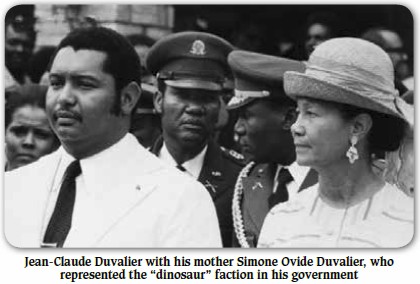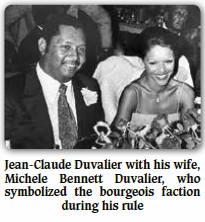|
 Karl Marx
once famously remarked that history repeats itself “the
first time as tragedy, the second time as farce.”
This maxim comes to mind when examining the class
dynamics surrounding the final days of President Michel
Martelly’s regime in Haiti today. They are similar to
those of 30 years ago, when the dictatorship of
Jean-Claude “Baby Doc” Duvalier was unraveling.
To compare the Haiti of 1986 to that of 2016, one
must understand the nation’s underlying class make-up.
A Quick History
After Haiti’s birth in 1804, two
ruling classes emerged. The first was a comprador
bourgeoisie, whose capital was invested and reproduced
in the importation of foreign manufactured goods and the
export of Haiti’s agricultural products, chiefly sugar,
coffee, and cacao. The other ruling group was the big
landowners, or grandons, who owned, leased, or controlled Haiti’s farmland. In a
semi-feudal arrangement, sharecroppers, known as
dè mwatye (two halves), tithed a large portion of their cash crops
to the grandons.
Haiti’s turbulent coup d’état-scarred history
reflects the struggle between these two rival ruling
groups for state power, and hence economic advantage.
In 1915, U.S. Marines began a two decade military
occupation until 1934, during which time they favored,
for both racist and economic reasons, the largely (but
far from completely) lighter-skinned comprador
bourgeoisie.
The reaction to the brutal, bloody, racist U.S.
regime was the emergence in 1946 of
grandon-leaning
President Dumarsais Estimé, whom Gen. Paul Magloire
ousted in a 1950 coup on behalf of Haiti’s bourgeoisie.
Magloire’s corrupt regime gave rise to the election in
1957 of Dr. François “Papa Doc” Duvalier, who had been
Estimé’s Health and Labor Minister and was a champion of
the grandons.
To resist the political pressure and
counter-attack of the bourgeoisie and Washington (which
tolerated but was not comfortable with his regime),
Duvalier formed an infamously repressive and arbitrary
paramilitary force known as the Volunteers for National
Security (VSN), or, informally, the Tonton Macoutes
(Uncle Sack). Duvalier’s vicious corps killed tens of
thousands of Haitians, often under the banner of
“fighting Communism” and its spread from neighboring
Cuba.
Papa Doc died in 1971, passing on his title of
“President for Life” to his son, Jean-Claude. But Baby
Doc had attended elite schools with the children of
Haiti’s bourgeoisie, so his regime became something of a
hybrid. Half of it was dominated by generals and
strongmen from Papa Doc’s clique, known as the
“dinosaurs,” while the other half was made up of
bourgeois “technocrats,” either friends from school or
reformers suggested by Washington. The “technocrats”
favored foreign investment and capitalist development,
which made more inroads into Haiti after Papa Doc’s
death. In 1980, Jean-Claude married a bourgeois
princess, Michele Bennett, whose father imported cars
and exported coffee.
Under Jean-Claude, Michele Bennett became the
symbol of the bourgeoisie’s influence, while his mother
and Papa Doc’s widow, Simone Ovide Duvalier, represented
the Macoute sector.
Repressive, corrupt, and bipolar, Baby Doc’s
regime finally fell in 1986 due to a popular uprising
but also a change in U.S. policy to begin replacing its
revolution-provoking tin-horn dictators with
“technocrats” and pro-neoliberal politicians elected
with Washington’s financial backing and political
support.
Neo-Duvalierism Returns with Martelly
Fast forward 25 years to 2011.
Washington illegally shoehorns into power President
Michel Martelly, overruling Haiti’s sovereign
Provisional Electoral Council (CEP) with pressure from
the Organization of American States (OAS) and then U.S.
Secretary of State Hillary Clinton.
For 20 years, Haiti’s political scene had been
dominated by the alternating presidencies of former
liberation theologian priest Jean-Bertrand Aristide and
his erstwhile ally, enlightened bourgeois
agronomist/baker René Préval. Their governments had been
undermined, hobbled, and bowed by two U.S.-backed coups
d’état in 1991 and 2004, and two ensuing foreign
military occupations.
The mass movement which first brought Aristide to
power in a 1990 election had a democratic,
anti-Duvalierist, anti-imperialist agenda. Martelly’s
Washington-assisted rise was the return of a
neo-Duvalierist regime, with a “Macoute” wing and a
bourgeois wing, and in post-earthquake Haiti, it aimed
to snuff out the weakened but persevering popular
movement.
Over the previous three decades, Haiti’s
traditional semi-feudal agricultural-export economy had
been largely destroyed. Although still importing motor
vehicles, refrigerators, computers, and perfume, Haiti’s
comprador bourgeoisie had moved mostly into building,
owning, and managing assembly factories producing
electronics and clothing for the U.S. market.
The dè
mwatye peasant agriculture that once supported the
grandons had
largely been crushed by the neo-liberal dumping of
foreign products – particularly rice – from the U.S. and
the neighboring Dominican Republic. The changing
grandon class,
with its recent Macoute past, increasingly turned to
illicit trades like drug-trafficking, kidnapping, land
theft, and the black-market for its livelihood and
gravitated towards careers in the police and
Martelly-resurrected Haitian army, which had been
demobilized by Aristide in 1994.
Representing the bourgeoisie under Martelly was
his Prime Minister and long-time business partner
Laurent Lamothe, who was trained in business at schools
in Florida and had become a rich, successful
telecommunications magnate.
Representing the Duvalierist wing were Martelly’s
wife, Sophia St. Rémy, whose father and brother were
drug traffickers, along with the children of many
prominent officials from the Duvalierist era like
Constantin Mayard-Paul, Claude Raymond, Mme. Max
Adolphe, and Adrien Raymond.
Even Baby Doc’s son, Nicolas, had a job in the
Martelly government, as did some of Jean-Claude’s former
ambassadors like Daniel Supplice and Dr. Pierre Pompée.
Also periodically part of Martelly’s government
was the flamboyant pundit Stanley Lucas, the scion of an
infamous peasant-massacring Jean Rabel
grandon
family, who, as an agent of Washington’s International
Republican Institute (IRI), had a prominent role in the
lead-up to the 2004 coup against President Aristide.
In its composition and program, the
Martelly/Lamothe government was a virtual photocopy of
Jean-Claude’s regime, using the same economic
cornerstones of tourism and sweatshops. It even
resurrected the same slogan that the Jean-Claudistes had
coined: “Haiti is open for business.”
But just like Baby Doc’s, Martelly’s regime was
marked by outrageous excess, infighting, dysfunction,
corruption, and repression, leading to a mass rebellion
which almost drove it from power in late 2014. To save
his presidency, Martelly sacrificed his Prime Minister,
Lamothe, who would have been the presumptive
presidential candidate of Martelly’s Haitian Bald-Headed
Party (PHTK) in 2015. (Constitutionally, Haitian
presidents are limited to two non-consecutive terms).
For his PHTK successor, Martelly turned to an
unknown provincial businessman, Jovenel “Neg Banann”
Moïse, who had developed, with a $6 million government
subsidy, a tax-free agro-industry “Agritrans,” exporting
bananas mainly to Europe.
With an export-oriented agribusiness built on the
dispossession of small peasants, Jovenel Moïse
represents what Haitians call the “Macouto-bourgeois”
alliance that characterized the regimes of Martelly and
Baby Doc.
Many also speculate that the state lands now
leased to Agritrans would eventually be turned over to
foreign mining interests to continue their now-stalled
exploration and environmentally-destructive mining for
gold in Haiti’s northern mountains.
The children of Haiti’s comprador bourgeoisie and
grandons, as well as other privileged petit-bourgeois strata,
usually go to school and college overseas in Europe, the
U.S., or Canada. There, they often become doctors,
lawyers, engineers, or some other professionals, taking
their place in Haiti’s
classe moyenne, or middle class.
With the degeneration of the Haitian economy,
scores of the classe moyenne have flocked to politics to get a piece of the state,
which has become Haiti’s most viable “industry” in
recent years.
The Struggle Ahead
Through the electoral fraud he
engineered in the Oct. 25 first round of Haiti’s
presidential race, Martelly sought to install Jovenel,
who was to go to a second-round with a leading 33% of
the vote (although a Brazilian exit poll suggests he
placed fourth with just 6% of the vote). That second
round, last scheduled for Jan. 24 after two
postponements, was suspended indefinitely on Jan. 22,
and five of the nine CEP members, including
President Opont Pierre-Louis, have resigned.
Although there were 54 presidential candidates,
there are only three heavyweights in the opposition to
Jovenel and Martelly, and two of them are “Lavalas.”
The first Lavalas candidate is Dr. Maryse
Narcisse of former Pres. Jean-Bertrand Aristide’s
Lavalas Family party (FL), who supposedly placed fourth
with 7% of the vote. Then there is the breakaway
Dessalines Children platform (PD) of former Sen. Moïse
Jean-Charles, who supposedly placed third with 14% of
the vote.
The third heavyweight is supposed second-place
finisher (with 25%) Jude Célestin of the Alternative
League for Haitian Progress and Empowerment (LAPEH),
which is affiliated (albeit informally) with Préval’s
platforms Vérité and Inite, under whose banner Célestin
ran in 2010.
Both Washington and Martelly wanted to
marginalize the two Lavalas currents and keep them out
of any run-off. Although their leaderships adopt
moderate positions, their popular bases remain very
mobilized and dangerously radical.
Therefore, Washington favors a monolithic
two-party system in Haiti (like that in the U.S.), which
would establish an alternance between “acceptable”
players, parameters of debate, and political programs.
The Republican analogue would be the PHTK, while the
Democratic surrogate would come from the current Préval
constellation: LAPEH, Vérité, or Inite.
Not surprisingly, Lamothe, singer Wyclef Jean,
and large sectors of Haiti’s ruling elite have thrown
their support behind Célestin, who could be expected to
give the U.S. the same grudging but faithful
collaboration that Préval did.
Célestin and seven of the other leading
presidential runners-up (except the FL) are in a “Group
of Eight” (G8), whose unity is more formal than real.
While the masses in giant demonstrations demand the
elections’ annulment and Martelly’s arrest, the G8 and
FL do not. They insist instead on an “independent
evaluation commission” to review the Oct. 25 results,
each of the heavyweight candidates asserting that they
won the election in the first round. Whatever results
any evaluation commission finds, it will surely explode
the opposition’s tenuous unity.
Meanwhile, the masses continue to vent their
anger and frustration at Martelly and the dismal
elections he has finally delivered after four years of
delay.
Senate and National Assembly President Jocelerme
Privert has proposed a complicated transition predicated
on the Martelly’s Feb. 7 departure and the new
Parliament staying, although many new lawmakers’
elections are also hotly contested. The G8 proposes a
transition where fraudulently elected lawmakers would be
selectively “ejected.”
The missing element in this revolutionary
cocktail, at the present moment, is a vanguard,
revolutionary party or front to lead and champion the
masses’ increasingly radical demands. Currents like the
Dessalines Coordination (KOD), the Democratic Popular
Movement (MODEP), and others have been talking but have
not yet forged an operational unity.
However, if history is any guide, Haiti’s
political crisis and revolutionary potential promises to
continue for several months at least. The window after
Baby Doc’s fall in 1986 lasted for four years, until the
popular movement carried out a political revolution on
Dec. 16, 1990 with Aristide’s first election.
Many veterans and students of the struggles of
the 1980s and 1990s now realize that a deeper social
revolution – changing Haiti’s property relations, above
all concerning land – is necessary for any progressive
or revolutionary government to survive.
Furthermore, the ruling class is either divided
on or unsure of how to go forward and maintain power,
offering a unique opportunity for Haiti’s uprising.
All these factors offer hope that the anti-imperialist
movement among peasants, workers, and the urban
unemployed that began with Duvalier’s ouster 30 years
ago can finally make some headway after its many
setbacks.
|